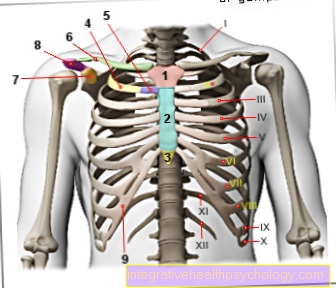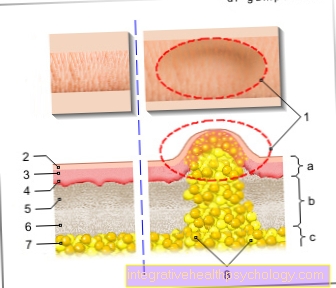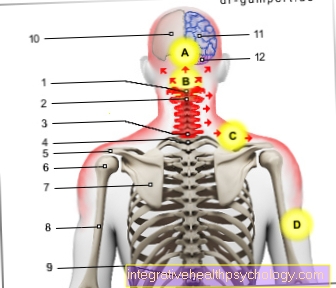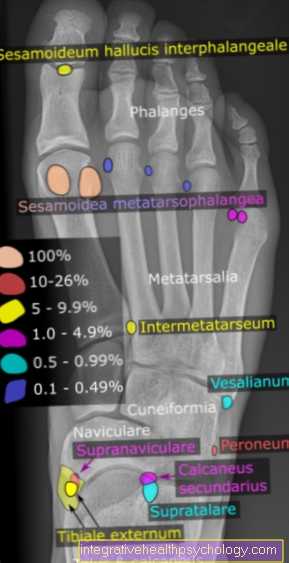Long-term memory
definitionLong-term memory is part of our memory. It is responsible for storing information over a long period of time. This also includes the ability to retrieve this information. It is distributed across different areas in our brain and can be roughly divided into two forms. These depend on the type of information that is stored.
The so-called declarative memory is responsible for storing facts, such as cooking recipes. The procedural memory, on the other hand, stores unconscious processes such as the ability to ride a bicycle. Long-term memory is very complex and many of its processes are not yet fully understood.
Read more on the topic: Memory

How does long-term memory work?
The way long-term memory works sometimes includes very complex processes that are still not fully understood today.
Every day everyone is surrounded by millions of impressions and information. Much of this information is not saved, but sorted out again immediately. Otherwise, the brain would be flooded, so to speak, with many unimportant things. Accordingly, only a part is remembered. This is initially the short-term memory and, after a further sorting out, the so-called working memory. The latter can store information for minutes to months, depending on its importance.
If certain information, such as vocabulary or the text of a song, is regularly repeated or also practiced, this can be transferred to the long-term memory. This works particularly well when the information is associated with intense feelings, as can often be the case with a song text, for example. Now the lyrics can be saved for years, even lifelong, depending on their importance and usage. This process is a way of learning.
To understand what happens in the brain, it should be mentioned that there are many nerve cells in our brain that are connected to each other. The more connections there are between them, the more information can be transmitted and stored. Accordingly, when information is learned and stored in long-term memory, new connections are made between nerve cells, also called neurons.
No limit for the amount of information is known from our long-term memory. If a person cannot remember something, it is not because the information is no longer there, but rather because it is stored incorrectly and can no longer be found.
Long-term memory can be divided into two forms. The so-called declarative memory stores various information such as cooking recipes, professional or even biographical knowledge. This information is received via an intermediate station, the hippocampus (a structure of the brain), and passed on at night during sleep. The so-called procedural memory, on the other hand, is responsible for storing unconscious, i.e. automatically running, processes. For example, it enables us to ride a bicycle without having to think about how it works. There is no intermediate stop here, practicing cycling is, so to speak, storing this information itself.
How can you train long-term memory?
There are many different methods that can help improve and train long-term memory.
For this it is very important that the information to be learned is linked with emotions or other memorable associations or features. This means that most things, like vocabulary or road signs, are better remembered when connected to a thought. This can include, for example, an emotion, such as being particularly happy about a funny word or fear of a wrongly interpreted road sign. Information to be learned can also be visualized, i.e. linked to an image in front of the inner eye. As a result, the memory is often better able to reproduce the information by calling up the image.
Another important component of long-term memory improvement is the fact that the information to be memorized requires frequent repetition and practice. There is no getting around it here, as this is the only way to effectively establish and strengthen connections between the nerve cells in the brain. Regular repetition of information can sometimes signal the brain, so to speak, that it is important enough for long-term memory.
Read more on the topic: Concentration training
What are the causes of poor long-term memory?
Poor long-term memory can have many causes.
It doesn't always have to be dementia or Alzheimer's, as is often thought. Often harmless influences are to blame for a temporary disruption of long-term memory. After this has been eliminated, the long-term memory usually returns completely. A temporarily poor long-term memory can result, for example, from a prolonged lack of sleep or a permanently increased stress level. Other psychological stress, such as the sudden death of a loved one, can temporarily impair long-term memory. Likewise, something positive, such as a fresh love, can also reduce the performance of long-term memory.
If the poor long-term memory persists over a long period of time, a doctor should be consulted to clarify the cause. In such cases, other triggers usually come into question. Long-term excessive consumption of alcohol and drugs can cause poor long-term memory. Dementia is also an option. Alzheimer's, a specific form of dementia, can also have a long-term negative effect on long-term memory.
You might also be interested in the topic: Transient global amnesia
Can you also lose long-term memory completely?
Long-term memory as such is not a separate part of the brain. Rather, it can be thought of as several interlinked chains of connections between different nerves. Accordingly, it is unlikely that an injury will damage the entire long-term memory with all nerve connections. It is much more likely that part of the long-term memory will be lost after a trauma, such as a car accident with a severe head injury. However, many connections between nerve cells can often be re-established through practice and repetition.
Read more on the topic: Amnesia
Are there tests to test long-term memory performance?
There are several ways to check long-term memory. However, there is no generally recognized test for the performance of long-term memory.
Different types of tests and questionnaires can be found on the Internet. However, these should be tried with caution. A test that can be carried out within half an hour, for example, cannot adequately measure the performance of the long-term memory, which can store information over years. An IQ test is also not an appropriate way to check long-term memory ability. In general, it is difficult to evaluate the performance of long-term memory with points, for example. For short-term memory, on the other hand, there are various tests that can provide an overview of its performance.
Therefore it makes more sense to test the performance of the long-term memory with your own review. To this end, an attempt can be made to retrieve various pieces of information learned in the past.
What is the difference to short-term memory?
In contrast to long-term memory, short-term memory is responsible for briefly storing information. Different types can be distinguished here. We perceive a great deal of information every second, which ends up in what is known as ultra-short-term memory. Here the information only remains for a few seconds and is then largely sorted out again. The rest of the information ends up in the actual short-term memory. This is responsible for storing information for a few minutes and, depending on the type of information, usually comprises around five to nine pieces of content. Accordingly, there is a relatively clear limit to the amount of information that can be stored in short-term memory.
Long-term memory, on the other hand, has no previously known limit for the amount of information that can be stored. Furthermore, long-term memory can store information for months to years, even a lifetime. The short-term memory, on the other hand, is responsible for storing information for a short period of time, often only a few minutes. The intermediate stage between short and long-term memory is working memory, which can store information for minutes to months.
Read more on the topic: Short term memory
Where is long-term memory located in the brain?
Long-term memory has no fixed location in the brain, as different areas of the brain are responsible for long-term storage of information. Therefore the question of the localization cannot be answered exactly in this sense. Long-term memory can be thought of as having many different chains of nerve cells connected to one another. Certain areas play a special role in the functioning of long-term memory. This includes, for example, the hippocampus, which serves as a kind of intermediate station, primarily to store facts over the long term while sleeping. Areas in the front brain are also very important for long-term memory.
Read more about: The anatomy of the brain
How does long-term memory change after a stroke?
A stroke can affect many different areas of the brain. This can affect parts of long-term memory. Information such as the names of relatives or birthdays can suddenly be missing, even if the person concerned always knew this beforehand. However, these gaps in memory can often be filled again through exercises and repetitions.
Read more about here: Memory loss after a stroke





























